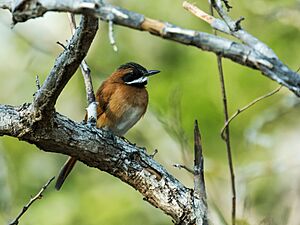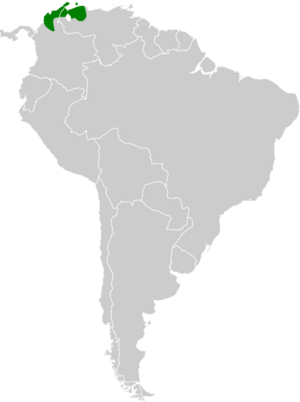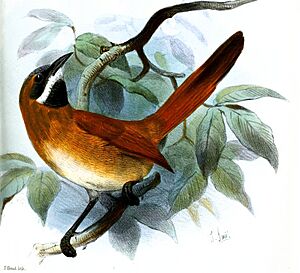White-whiskered spinetail facts for kids
Quick facts for kids White-whiskered spinetail |
|
|---|---|
 |
|
| Conservation status | |
| Scientific classification | |
| Genus: |
Synallaxis
|
| Species: |
candei
|
 |
|
The white-whiskered spinetail (Synallaxis candei) is a type of bird in the ovenbird family called Furnariidae. This bird lives in Colombia and Venezuela. It gets its name from the white stripes that look like whiskers on its face.
Contents
About Its Name and Family
Scientists group birds to show how they are related. This is called taxonomy. The white-whiskered spinetail was first placed in the group Synallaxis. Later, some thought it belonged to a new group called Poecilurus. But by 2000, most scientists agreed it should stay in Synallaxis. A study in 2011 confirmed this. It also showed that this bird is a 'sister species' to the rufous-breasted spinetail, meaning they are very closely related.
The white-whiskered spinetail has three types, called subspecies. They are S. c. candei, S. c. atrigularis, and S. c. venezuelensis. Each subspecies has slight differences.
The bird's scientific name, candei, honors Admiral Antoine Marie Ferdinand de Maussion de Candé. He was an explorer who traveled in South America.
What It Looks Like
The white-whiskered spinetail is about 15 to 17 cm (5.9 to 6.7 in) long. That's about the length of a pen. It weighs around 14 to 16 g (0.49 to 0.56 oz), which is very light. Male and female birds look the same.
Adult birds of the main subspecies have a wide white "moustache" on their face. They also have a wide reddish-brown stripe above their eye. Their face is mostly blackish.
Their head is dark gray with black spots. Their back, rump, and upper tail feathers are bright reddish-brown. Their wings are also bright reddish-brown, but the tips of their flight feathers are dusky. The first two-thirds of their tail is bright reddish-brown, and the last third is dark brownish-gray.
Their chin is white, and their throat is black. Their chest and sides are bright reddish-brown. Their belly is white, and the feathers under their tail are pale reddish-brown. Their eyes are dark brown. Their beak is black, sometimes with some yellowish on the bottom part. Their legs and feet are gray or bluish-gray.
Other subspecies have slightly different colors. For example, S. c. atrigularis has a brown back and a duller chest. S. c. venezuelensis is paler overall.
Where It Lives
The white-whiskered spinetail lives in northern Colombia and northwestern Venezuela. Different subspecies live in different areas.
- The main subspecies, S. c. candei, is found in northern Colombia.
- Subspecies S. c. atrigularis lives in the middle of the Magdalena River valley in northern Colombia.
- S. c. venezuelensis is found in far northern Colombia and goes east into northwestern Venezuela.
This bird likes to live in tropical dry forests and dry scrublands. It also lives in overgrown fields and near the edges of mangrove trees. In Colombia, it lives from sea level up to about 300 m (1,000 ft) high. In Venezuela, it can be found up to 1,100 m (3,600 ft) high.
How It Behaves
Movement
The white-whiskered spinetail stays in the same area all year round. It does not migrate.
Feeding
This bird eats arthropods, which are small creatures like insects and spiders. It usually looks for food in pairs. It finds its prey mostly on the ground. It also picks food from twigs and branches up to about 2 m (7 ft) above the ground.
Life Cycle and Reproduction
Scientists believe the white-whiskered spinetail breeds during the rainy season. This is usually from October to January. They are thought to be monogamous, meaning a male and female bird stay together for breeding.
Their nest is made of thorny sticks. It is shaped like a long, wide tunnel. The outside of the nest is covered with smaller twigs and bark. The inside of the nest is lined with leaves and sometimes even snake skins. The nest is usually placed in a thorny bush. It is built between 1.3 and 2.5 m (4 and 8 ft) above the ground.
A female bird usually lays three to four eggs. We do not know how long the eggs take to hatch. We also do not know how long it takes for the young birds to leave the nest. Details about how the parents care for their young are also not known.
Sounds and Calls
The white-whiskered spinetail has a special song. It has four notes, and the middle two are stronger. It sounds like a repeated "nasal 'a-dít-dít-du'". Its call is a "nasal 'paa-pip'". When the bird is worried, it makes a "nasal 'naaaa'" sound.
Status
The IUCN (International Union for Conservation of Nature) has looked at the white-whiskered spinetail. They have decided it is a species of "Least Concern." This means it is not currently in danger of disappearing.
The bird lives in a fairly large area. We do not know exactly how many white-whiskered spinetails there are. However, scientists believe their numbers are stable. No immediate threats have been found for this bird. It is considered to be fairly common or common in the places where it lives.



